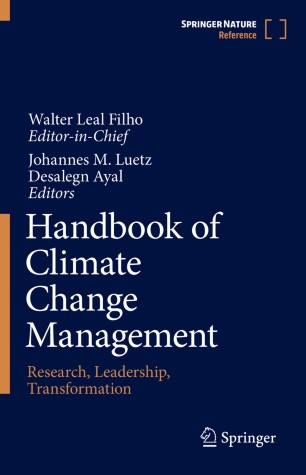Climate change is one of the most important challenges of modern times. It is one of the “mega themes,” along with population growth, hunger, pollution, and food security, and a problem which is global in nature, but whose impacts are felt at the local level.
And since climate change is a problem whose causes and consequences need to be addressed, there is a perceived need to identify ways to manage it. It is against this background that the Handbook of Climate Change Management has been produced.
It is meant as a publication which showcases approaches, methods, theories, and concrete projects, which illustrate the different means via which climate change can be managed, across various subjects and perspectives. It adds a welcome contribution to the literature, since it documents concrete examples of what is being done to manage climate change and its impacts. This handbook is structured along the following parts:
Part 1 – Agriculture and Technology-Oriented Approaches to Climate Change Adaptation
This part contains a set of chapters that looks at the connections between agriculture and climate change. Apart from chapters looking at agricultural resilience to climate change, it also considers matters related to transformation of smallholder farming systems and strategies deployed to ensure the food security of small-holder farmers. The impacts of climate change and adaptation strategies practiced by small scale farmers are also considered in Part 1.
Part 2 – Socio-economic Aspects of Climate Change Adaptation
This part describes the socio-economic aspects of climate change adaptation, which encompasses chapters looking at regulations, the role of international finance in supporting planned adaptation priorities in least developed countries, and assessments of climate change-induced migration. Also, the characteristics and determinants of resilience of smallholder farmers are explored, along with aspects of climate change governance. A due emphasis is also given to aspects of climate change governance, and the role of indigenous peoples in climate change contexts.
Part 3 – Ecosystems-Based Approaches to Climate Change Adaptation
This part covers elements related to ecosystems-based approaches and how they relate to climate change adaptation. This includes adaptation approaches for conservation in protected areas and coastal zones and in wetlands, and chapters which look at the impacts of climate and land use change on surface water content and quality. A special emphasis is also given to the protection and restoration of ecosystems, including resilience building solutions for mountain smallholders.
Part 4 – Communication, Education, and Training on Climate Change Adaptation
This part focuses on aspects related to communication, education, and training on climate change adaptation, which includes chapters that outline the role of participation in adaptation, the use of systems thinking in education to foster adaptive capacity and move towards resilient rural communities, and beliefs and concerns about global warming. This part also entails chapters which address the subject matter of capacity building and how to mobilize the various stakeholders to increase climate change resilience. To this purpose, some chapters address matters related to climate risk communication and how to mobilize communities.





